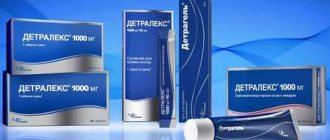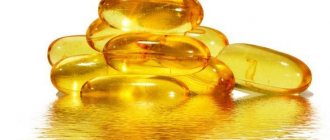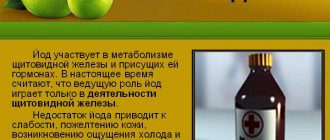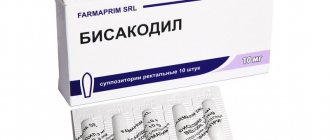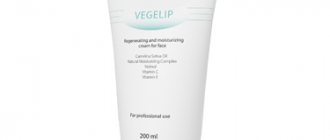Vitamin A is necessary for maintaining good vision, the functioning of the immune system, and the proper formation and growth of cells in the body. It plays an important role in antioxidant protection, heart function, lungs, kidneys and other organs.
Vitamin A is the name of a group of fat-soluble retinoids, including retinol, retinal, and retinoic acid. Precursors of vitamin A include carotenoids, primarily beta-carotene.
The source of retinoids is animal products, and carotenoids, which after consumption can be converted into active vitamin A, are found exclusively in plants. Beta-carotene (β-carotene) is a plant pigment that gives red, orange, and yellow vegetables their vibrant color. Carrots, for example, contain a lot of beta-carotene.
Retinol Activity Equivalents (RAEs)
Vitamin A can be obtained from food or in the form of dietary supplements. However, it is important to understand that while animal-based vitamin A is efficiently absorbed and converted into active forms of vitamin A, carotenoids such as beta-carotene are less easily absorbed and absorbed. Moreover, the efficiency of converting provitamin A into retinol varies greatly and depends on factors such as food source, preparation method, and the individual's digestive system.
The latest accepted international standards for measuring vitamin A activity are retinol activity equivalents (RAE). It has been found that 2 mcg of beta-carotene in oil as a dietary supplement can be converted by the body to 1 mcg of retinol, resulting in a RAE ratio of 2:1. To provide 1 mcg of retinol, you need 12 mcg of beta-carotene from food, resulting in a 12:1 ratio. Other provitamin A carotenoids in food are much less absorbed than beta-carotene, resulting in a RAE ratio of 24:1.
Table 1. Retinol activity equivalents (RAEs) for provitamin A carotenoids
Recommended intake of vitamin A
The Vitamin A Dietary Recommendations (RDA) were revised by the Food and Nutrition Board of the US Institute of Medicine in 2001. The RDA is the recommended amount of vitamin A required by almost the entire population to ensure adequate vitamin A stores in the liver, maintain normal reproductive function, gene expression, immunity, and vision.
Table 2. Recommended Daily Allowances for Vitamin A (RDA)
*Adequate Intake (AI), equivalent to the average vitamin A intake of healthy breastfed infants.
Permissible upper level of consumption
Upper levels apply to retinol or its ester forms such as retinyl palmitate. No upper tolerable levels have been established for beta-carotene and other carotenoids.
Table 3. Vitamin A Ultimate Intake Levels (UL)
Vitamin A capsules may contain a mixture of retinol and beta-carotene.
In such cases, only the retinol content of the supplement should be considered to determine whether a given vitamin A intake exceeds the upper limit.
Release forms and storage conditions
Many foreign and domestic pharmaceutical companies produce the vitamin we are considering (retinol acetate) in capsules. Instructions for use for each drug may differ slightly.
Vitamins are sold in gelatin capsules, injection solutions and film-coated tablets.
The dosage may vary significantly (33,000, 50,000, 100,000 IU). The selection of such a drug should be carried out by the attending physician.
You can purchase the medicine without a prescription. Store for two years in a dark, dry place at a temperature of 4 to 15 degrees Celsius.
These vitamins must be hidden from children, because an overdose is extremely dangerous for the body.
Units of change: IU and mcg RAE
On nutritional supplement labels, you may find vitamin A dosages listed in IU or mcg (RAE). Unlike RAE, vitamin A IU does not reflect the bioavailability of vitamin A from various dietary sources.
Therefore, starting in January 2021, the U.S. Food and Drug Administration (FDA) required manufacturers to use new labels that provide information about the amount of vitamin A in mcg RAE. RAE (retinol activity equivalent) is the biological activity equivalent of vitamin A, which is converted by the body into retinol. Companies with annual sales of less than $10 million may continue to use the old vitamin A international unit (IU) labels until January 2021.
Converting RAE to IU, and vice versa, is only possible if the source of vitamin A is known. To convert IU and RAE, use the following formula:
- 1 IU retinol = 0.3 mcg RAE
- 1 IU beta-carotene from supplements = 0.15 mcg RAE
- 1 IU beta-carotene from food = 0.05 mcg RAE
- 1 IU alpha-carotene or beta-cryptoxanthin from food = 0.025 mcg RAE
For example, a daily value of 900 mcg RAE for adolescent and adult men is equivalent to 3,000 IU if the food or supplement source is retinol. The same 900 mcg of RAE would be equivalent to 6,000 IU if the source of beta-carotene were dietary supplements. Therefore, a diet containing 900 mcg RAE provides between 3,000 and 36,000 IU of vitamin A, depending on the foods or supplements consumed.
Health Risks from Excessive Vitamin A Consumption
Because vitamin A is fat-soluble, the body stores excess vitamin A, primarily in the liver. It is important to know that excess vitamin A can cause toxicity in the body, known as vitamin A hypervitaminosis.
Manifestations of hypervitaminosis A depend on the amount and duration of intake. Chronic intake of excess vitamin A leads to increased intracranial pressure (pseudotumor cerebri), dizziness, nausea, headaches, skin irritation, joint and bone pain, coma, and even death. Although hypervitaminosis A can be caused by excessive food intake, the condition is usually the result of consuming too much vitamin A capsules. After stopping vitamin A intake, its content in tissues decreases for a long time, and the resulting liver damage may be irreversible.
Pregnant women should strictly adhere to the recommended intake of vitamin A and coordinate its intake with their doctor. Consumption of vitamin A capsules exceeding the permissible limit and treatment with certain topical ointments (eg, Retinoic ointment) may cause birth defects. These birth defects may include malformations of the eye, skull, lungs, and heart.
Taking large amounts of beta-carotene and other carotenoids does not cause serious side effects ( ). The fact is that beta-carotene is converted into active vitamin A only as needed, so there is no risk of overdose.
Unlike vitamin A, beta-carotene does not interfere with embryonic development and is not toxic (). Even large supplemental doses (20,000–30,000 mcg/day) of beta-carotene over the long term did not cause toxicity in the body.
The most significant effect of long-term excess beta-carotene is carotenoderma, a harmless condition in which the skin turns yellow-orange ( ). This condition resolves after stopping beta-carotene intake.
However, people who smoke are advised to avoid taking beta-carotene supplements. People who smoke, and perhaps those who used to smoke, should avoid beta-carotene supplements and multivitamins that contain more than 100% of their daily value of vitamin A. This is because research has linked high doses of these nutrients to increased risk of lung cancer in smokers.
Side effects
Allergic manifestations
: itching, rashes, dry skin, dry mouth, fever.
In the area of the gastrointestinal tract
: nausea, lack of appetite, less often vomiting.
In the area of the nervous system
: lethargy, drowsiness, loss of sleep, fatigue, headaches, irritability.
Other
: disruptions of the menstrual cycle; weakening of hair follicles; pain in the stomach; gait disturbance; discomfort in the bone tissues of the lower extremities.
Vitamin A deficiency
Vitamin A deficiency is common in many developing countries. According to the World Health Organization, 190 million preschool children and 19 million pregnant women worldwide have serum retinol concentrations below normal. In these countries, low vitamin A intake has the greatest impact on health, especially during periods of high nutrient need, such as infancy, childhood, pregnancy and breastfeeding.
In developing countries, vitamin A deficiency usually begins in infancy, when infants do not receive enough colostrum or breast milk. Chronic diarrhea also leads to excessive loss of vitamin A in young children, and vitamin A deficiency increases the risk of diarrhea. The most common sign of vitamin A deficiency in young children and pregnant women is xerophthalmia. One of the early signs of xerophthalmia is night blindness, or the inability to see in low light or darkness. Vitamin A deficiency is one of the leading causes of preventable blindness in children.
Serum retinol concentration is a common method used to assess vitamin A deficiency. Low plasma retinol levels are the basis for diagnosing acute vitamin A deficiency in the body. However, normal blood levels of vitamin A do not reflect total vitamin A levels in the body, since serum retinol does not decrease until liver stores become dangerously low. Therefore, other biochemical methods have been developed that can assess the reserve amount of vitamin A in the liver. These include dose-response tests, in which plasma retinol levels are measured before and after administration of a small amount of vitamin A. An increase in plasma retinol levels of 20% or more indicates a vitamin A deficiency in the body.
Contraindications
Do not take when:
- Personal intolerance to the components of the drug;
- Hypovitaminosis A;
- Chronic pancreatitis;
- Gallstone diseases;
- Inflammatory skin diseases in acute forms;
- In childhood;
- During pregnancy and lactation.
Carefully
: Patients with renal failure or cardiac failure of 2-3 degrees, with cirrhosis of the liver, viral hepatitis, nephritis, with alcoholism, in old age.
Vitamin A capsules
Figure 1
The main forms of vitamin A in supplements are retinyl palmitate and retinyl acetate. Beta-carotene capsules are also a source of vitamin A. Some supplements may contain a combination of retinol and beta-carotene. In this case, the percentage of each source should be listed in the “Supplement Facts” section on the back of the label (Figure 1).
Some multivitamin supplements available in the US contain up to 5,000 IU of retinyl palmitate, which corresponds to 1,500 mcg RAE, which is significantly higher than the current daily intake for vitamin A. This is because the daily values (DV) used by the FDA US Drug Administration (FDA) labeling guidelines for supplements are based on the outdated RDA standards established back in 1968.
Because a retinol intake of 5,000 IU/day (1,500 mcg RAE) may be associated with an increased risk of osteoporosis in older adults, some companies have reduced the retinol content of their multivitamin supplements to 2,500 IU (750 mcg RAE).
Patient reviews
The therapist prescribed Retinol as a complex therapy for conjunctivitis. Within a few days after taking it, I felt an improvement in my condition. Moreover, I noticed that the oil form of the medicine does an excellent job of healing cuts - I applied the product to a fairly deep cut, as a result of which the wound quickly healed after just three days.
Natalia Z.
The advantage of the drug is not only its effectiveness, but also its low cost, which is very rare these days. I tried the vitamins on myself when I began to notice that my vision began to deteriorate very sharply. The doctor prescribed a Retinol solution, which helps restore vision. Exactly two weeks later, I noticed how my vision began to gradually recover. Of course, at the same time as taking the drug, I did special exercises for the eyes and went to procedures. I can safely say that the complex treatment helped me quickly.
Julia F.
Received a severe household burn. My therapist prescribed me a liquid form of the drug Retinol and told me to smear the wound at least five to six times a day. After one day of using the oil solution, I felt that the strong burning sensation and swelling in the wound area quickly subsided, and the pain syndrome disappeared. After three days of using the medication, I completely forgot that I had ever had a burn. “Retinol” really has a quick effect, and I did not experience any adverse reactions.
Alexey P.
Originally posted 2018-01-29 08:01:59.
Retinyl palmitate
Now Foods, Vitamin A, 25,000 IU, 250 Capsules
Buy at a discount
25,000 IU of retinyl palmitate is equivalent to 7,500 mcg of vitamin A and is 500% of the daily value.
Now Foods, Vitamin A, 10,000 IU, 100 Capsules
Buy at a discount
10,000 IU of retinyl palmitate is equivalent to 3,000 mcg of vitamin A and is 200% of the daily value.
Solgar, Vitamin A Dry, 5000 IU, 100 Tablets
Buy at a discount
5000 IU of retinyl palmitate is equivalent to 1500 mcg of vitamin A and is 167% of the daily value.
How to use correctly
The dosage is selected taking into account the indications for which retinol acetate capsules are prescribed. Instructions for use provide the following therapeutic regimen:
- For adults. For prevention 33,000 IU per day, for the treatment of skin diseases - 50,000-100,000 IU.
- For children. In the first case, 1,000-5,000 IU, in the second - 5,000-20,000 IU.
For other pathologies, the amount of retinol acetate is selected individually.
Beta carotene
Now Foods, Natural Beta Carotene, 25,000 IU, 180 Capsules
Buy at a discount
One capsule contains: 3750 mcg of beta-carotene, obtained from Dunaliella salina algae.
Dunaliella salina is a species of green microalgae that grows in salty seawater. Known for its antioxidant activity due to its ability to synthesize large amounts of carotenoids, which are actively used in cosmetics and food supplements.
Solgar, Beta Carotene Dry, 3,000 mcg, 250 Tablets
Buy at a discount
One capsule contains: 3000 mcg of beta-carotene.
This vitamin A capsule is oil-free and suitable for those who have difficulty digesting oil-based supplements.
The complex contains vitamin A in the form of beta-carotene and a mixture of other carotenoids (alpha and beta carotene, lutein, zeaxanthin, cryptoxanthin). Suitable for vegans.
California Gold Nutrition, AstaCartenoid, Lutein, Lycopene, Astaxanthin Complex, 30 Capsules
Buy at a discount
I really like this complex, which has an iTested quality certificate. One capsule provides your daily value of beta-carotene, enriched with a blend of other antioxidant carotenoids derived from calendula flowers, tomatoes and algae.
One capsule contains: 1800 mcg of beta-carotene, which is equivalent to 900 mcg of RAE retinol and corresponds to 100% of the daily value.
Lutein and zeaxanthin from calendula flowers. Lutein and zeaxanthin are concentrated in the macula and lens of the eye, where they protect eye tissue from oxidative stress.
Alpha, beta and gamma carotene. The body converts these carotenoids into vitamin A, which is essential for maintaining night vision.
Lycopene from tomatoes. Lycopene is an antioxidant that protects against damage caused by reactive oxygen species.
Phycocyanin and astaxanthin are antioxidant carotenoids found in algae that protect lipids from peroxidation.
Indications for use
Retinol is recommended for use in cases of hypovitaminosis and vitamin A deficiency.
As part of complex therapy, the drug is used in the treatment of the following diseases:
- Infectious and inflammatory lesions (dysentery, measles, influenza, bronchitis, tracheitis, etc.);
- Eye diseases (eczematous eyelid lesions, keratomalacia, xerophthalmia, hemeralopia, retinitis pigmentosa);
- Gastrointestinal diseases (peptic ulcer of the stomach and duodenum, erosive gastroduodenitis);
- Cirrhosis of the liver;
- Diseases and lesions of the skin (ulcers, erosions, burns, frostbite, wounds, cracks, seborrheic dermatitis, hyperkeratosis, ichthyosis, neurodermatitis, psoriasis, skin tuberculosis, some forms of eczema).
The product is also used to prevent the formation of stones in the urinary and biliary tract.
Vitamin A for children
Cod liver oil is a natural source of vitamin A, as well as other nutrients such as omega-3 fatty acids and vitamin D-3. Therefore, some people prefer to take cod liver oil as a preventative measure rather than a separate vitamin A supplement.
However, keep in mind that cod liver oil does not contain as many vitamins as a dedicated vitamin A supplement. For this reason, it may be more suitable for people who are not vitamin A deficient and therefore do not need high doses of supplements.
The Vitamin A content in these supplements corresponds to children's standards.
Nordic Naturals, Arctic Cod Liver Oil, Lemon, 237 ml
Buy at a discount
Nordic Naturals is one of the most trusted brands in the nutritional supplement industry.
This oil is made from Atlantic cod and is third party tested for purity. The oil contains just three ingredients - cod liver oil (a rich source of omega-3), vitamin A and rosemary extract, which serves as a natural preservative.
One serving contains 13% of the daily value of vitamin A for children ages 1 to 3 years. Or 4% for adults and children over 4 years old.
Carlson Labs, Wild Norwegian Cod Liver Oil, Natural Lemon Flavor, 250 ml
Buy at a discount
Carlson is another trusted source of high-quality omega-3 fish oil supplements and wild Norwegian cod liver oil.
Their cod liver oil is certified by the International Fish Oil Standards (IFOS), the certification body for fish oil products that helps ensure the quality, purity and safety of the products.
In addition to vitamin D, vitamin E, and omega-3 fats, this supplement provides 28% of the daily value of vitamin A per serving.
Oslomega, Norwegian series, cod liver oil for children, natural strawberry flavor, 200 ml
Buy at a discount
Cod liver oil contains naturally occurring vitamins A and D and omega-3 fatty acids, including EPA and DHA. The supplement supports the development of the brain, nervous system and vision in children.
Manufactured in a current Good Manufacturing Practices (cGMP) compliant facility with quality assurance testing.
Where is the best place to buy vitamin A or beta-carotene?
- The iHerb website offers you products from world famous brands, which are sold in many pharmacies and retail stores.
- Guarantee of freshness and quality of products
- iHerb prices are 30–50% lower than pharmacy prices and may not differ from wholesale ones, which is due to direct deliveries and the absence of intermediaries.
- Orders are delivered to any corner of the world.
- 24/7 support via chat or contact details on the website.
How to get the most out of every iHerb purchase?
- Get a discount on all orders using promo code NIH688. To do this, when placing an order, follow the link or enter the code NIH688 manually.
- Additional 10% discount on all orders over $60. To activate an additional 10% discount on all orders over $60, click on code VALUE60.


